
Rosaceae, the rose family, is a medium-sized family of flowering plants that includes 4,828 known species in 91 genera.

The rose subfamily Rosoideae consists of more than 850 species, including many shrubs, perennial herbs, and fruit plants such as strawberries and brambles. Only a few are annual herbs.

Fragaria is a genus of flowering plants in the rose family, Rosaceae, commonly known as strawberries for their edible fruits. There are more than 20 described species and many hybrids and cultivars. The most common strawberries grown commercially are cultivars of the garden strawberry, a hybrid known as Fragaria × ananassa. Strawberries have a taste that varies by cultivar, and ranges from quite sweet to rather tart. Strawberries are an important commercial fruit crop, widely grown in all temperate regions of the world.

Prunus is a genus of trees and shrubs in the flowering plant family Rosaceae that includes plums, cherries, peaches, nectarines, apricots, and almonds. The genus has a cosmopolitan distribution, being native to the North American temperate regions, the neotropics of South America, and temperate and tropical regions of Asia and Africa, There are 340 accepted species. Many members of the genus are widely cultivated for their fruit and for decorative purposes. Prunus fruit are drupes, or stone fruits. The fleshy mesocarp surrounding the endocarp is edible while the endocarp itself forms a hard, inedible shell called the pyrena. This shell encloses the seed, which is edible in some species, but poisonous in many others. Besides being eaten off the hand, most Prunus fruit are also commonly used in processing, such as jam production, canning, drying, and the seeds for roasting.

Potentilla is a genus containing over 500 species of annual, biennial and perennial herbaceous flowering plants in the rose family, Rosaceae.

Potentilla erecta is a herbaceous perennial plant belonging to the rose family (Rosaceae).
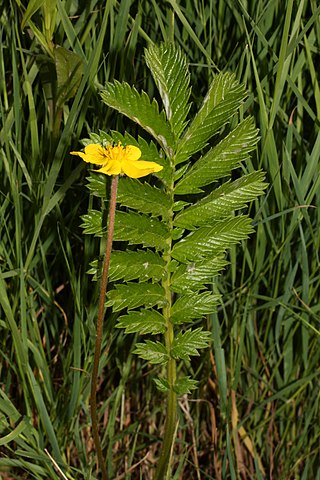
Argentina anserina is a perennial flowering plant in the rose family, Rosaceae. It is known by the common names silverweed, common silverweed or silver cinquefoil. It is native throughout the temperate Northern Hemisphere, often on river shores and in grassy habitats such as meadows and road-sides. The plant was originally placed in the genus Potentilla by Carl Linnaeus in his Species plantarum, edition 1, (1753) but was reclassified into the resurrected genus Argentina by research conducted in the 1990s. The reclassification remains controversial and is not accepted by some authorities. It is a species aggregate which has frequently been divided into multiple species.

Dasiphora is a genus of shrubs in the rose family Rosaceae, native to Asia, with one species D. fruticosa, ranging across the entire cool temperate Northern Hemisphere. In the past, the genus was normally included in Potentilla as Potentilla sect. Rhopalostylae, but genetic evidence has shown it to be distinct.
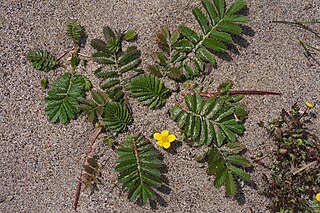
Argentina egedei, known as Eged's silverweed, is a flowering perennial plant in the rose family, Rosaceae. It is a halophyte native to Arctic and cool temperate coasts of the Northern Hemisphere, most commonly growing in salt marshes. The southern limits of the range are California and Long Island, New York in North America, and the Baltic Sea and coastal eastern Siberia in Eurasia. It is also sometimes called "Pacific silverweed", though this usually refers to Argentina pacifica and in any case does not describe the range of Eged's Silverweed well.

Potentilla reptans, known as the creeping cinquefoil, European cinquefoil or creeping tormentil, is a flowering plant in the family Rosaceae.

Potentilla indica, known commonly as mock strawberry, Indian-strawberry, or false strawberry, often referred to as a backyard strawberry, mainly in North America, is a flowering plant in the family Rosaceae. It has foliage and an aggregate accessory fruit similar to that of a true strawberry. It has yellow flowers, unlike the white or slightly pink flowers of true strawberries. It is native to eastern and southern Asia, but has been introduced to many other areas as a medicinal and an ornamental plant, subsequently naturalizing in many regions worldwide. It is considered invasive in some regions of the United States.

Argentina pacifica, sometimes called pacific silverweed, silverweed cinquefoil, or simply silverweed, is a low-growing perennial (6") with pinnately compound green leaves with silvery undersides. It is a member of the species aggregate known as Argentina anserina or Potentilla anserina. The yellow, saucer-shaped flowers appear late spring through summer. Pacific silverweed spreads very quickly in moist areas. Preferring salt marshes, river estuaries and shorelines, they are often seen growing alongside springbank clover. They need sun and regular water.

Sibbaldia tridentata is a species in the plant family Rosaceae. Its synonyms include the illegitimate name Sibbaldia retusa and Sibbaldiopsis tridentata. Under the latter name, it has been treated as the only species in the genus Sibbaldiopsis. Its English names include three-toothed cinquefoil, shrubby fivefingers, and wineleaf.
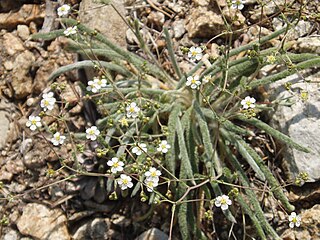
Potentilla santolinoides, also known as silver mousetail, stellariopsis, Sierra mousetail and mousetail ivesia, is a species of flowering plant in the rose family. It is endemic to California where it grows in several mountain ranges, including the Sierra Nevada and Transverse Ranges.

Drymocallis is a genus of plants formerly included with the typical cinquefoils (Potentilla). It contains three species known or suspected to be protocarnivorous, but more cinquefoils might eventually be moved here:
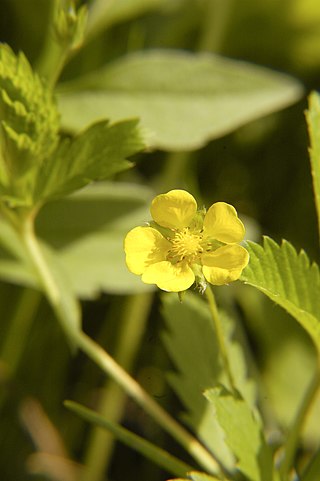
Potentilla simplex, also known as common cinquefoil or old-field five-fingers or oldfield cinquefoil, is a perennial herb in the Rosaceae (rose) family native to eastern North America from Ontario, Quebec, and Labrador south to Texas, Alabama, and panhandle Florida.

Potentilleae is a tribe of the rose family, Rosaceae.
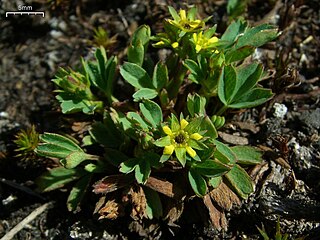
Sibbaldia is a genus of flowering plants of the family Rosaceae, with a circumpolar distribution, including the high Arctic. The type species is Sibbaldia procumbens. It is also in the Rosoideae subfamily.

Potentilla nivea, called the snow cinquefoil, snowy cinquefoil, and villous cinquefoil, is a species of flowering plant in the genus Potentilla, native to Subarctic Asia, North America, Greenland, and Europe, and the Subalpine Rockies and Alps. It comes in many ploidy levels; 2x, 3x, 4x, 5x, 6x, 7x, 8x and 10x.

Dasiphora fruticosa var. veitchii is a flowering plant in the family Rosaceae, native to Sichuan and Yunnan in China. It was first described as the species Potentilla veitchii by Ernest Henry Wilson in 1911, after he had earlier introduced it into gardens in the United Kingdom. Its scientific name and status have varied, and remained "unresolved" according to the Royal Horticultural Society as of May 2022. In horticulture, it may also be found under the names Potentilla davurica var. veitchii and Potentilla fruticosa var. veitchii. It is cultivated as an ornamental flowering shrub.



















